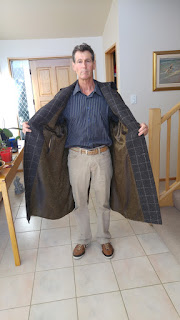Is your power bill higher than you would like? Well here is
a way to save some money with a quick little sewing project to spur you along.
The average clothes dryer uses 3 kW of power and the average
family of four does 9 loads per week. At 45 minutes per load, that is 20.25 kWh
per week and 1053 kWh per year. In comparison, the average refrigerator running
24 – 7 uses about 500 kWh per year. Where I live, power costs 37 cents per kWh
+ other fees so a dryer costs about $400 per year on average for the average
family of four.
So then, why not hang your laundry outside in the sun? I
happen to have the best view in the world for hanging laundry so it’s a
no-brainer for me.
Now you may have memories from your childhood of
hanging out laundry using a bag of clothes pegs that was hung on the clothes line day
in and day out and hosted occasional spiders, pine needles and other detritus
in addition to the clothes pegs. Who wants to hang up their clothes with them? So here is the solution – a clothes peg apron. It’s cute,
lives in the laundry basket, not outside with the bugs, and your clothes pegs
are always within reach.
A good friend of mine gave me her apron several years
ago. Her husband’s sister made it as a school girl in Germany in the 1950s.
Alas it is now on its last legs.
So I decided to clone it and make a new one. In fact, I made three. One for my husband’s daughter for Christmas, one for my sister-in-law for her birthday and now one for me!
So here is how I did it:
Materials:
1 ½ yards medium weight cotton (I used leftover fabric from a quilt I made for my daughter)
Thread to match
Cut 5 pieces:
1 – 25 inch wide, 22 inches long for main apron piece
1 – 15 inch wide, 13 ½
inch long for pocket (can use contrasting fabric)
1 – 18 ¾ inch wide, 4 inch long for waistband
2 – 28 inch wide, 4 inch long for ties
Assembly (5/8 inch seam allowances unless otherwise stated):
- Fold and press sides of main piece at 1/4 inch and then fold again 3/8 inch and press. Topstitch at 1/4 inch from edge.
- Fold and press hem of main piece at 1/4 inch then fold again 3/4 inch and press. Topstitch at 5/8 inch.
- Mark pocket piece at 4 inches from each bottom corner along bottom edge. Mark each side 9 inches from top. Fold and press each corner starting and ending at the marks. Trim the resulting triangle diagonally 5/8 inch from fold. Press in the remaining sides and bottom at 5/8 inch.
- Fold and press top edge of pocket at 1/4 inch then fold again 3/4 inch and press. Topstitch at 5/8 inch.
- Center the pocket piece 6 inches down from the raw edge of the top of the main apron piece. Topstitch at 3/8 inch from the folded edge in a continuous seam starting at the top corner of one side and finishing at the other top corner, leaving the top edge unsewn. Topstitch again close to the folded edge.
- Sew long machine stitch at just under 5/8 inch and again at 3/8 inch along top edge of main piece. Gather to a final width of 18 3/4 inches to match the waistband.
- Sew one short end of each tie to each end of the waistband. Trim to 1/4 inch and press open.
- Fold waistband/ties piece in half lengthwise, right sides together. Sew across tie ends, pivot and sew until 1/8 - 1/4 inch from waistband seam (this will make it easier to finish the waistband). Trim tie seams to 1/4 inch, closer at corners, turn and press ties.
- Pin waistband to gathered top of main piece and sew. Trim to 1/4 inch. Press unsewn waistband edge at a scant 5/8 inch, trim to 1/4 inch and pin pressed edge in position with about 1/8 inch overlapping the previously sewn seam. With right side up, stitch in the ditch starting and finishing 1/8 - 1/4 inch either side of waistband (ie on the ties) to close the little gap left in the previous step.
- Press. Fill the pocket with clothes pegs. Get the laundry out of the washing machine. Put on your new apron and hang out the clothes.
Enjoy!




























































